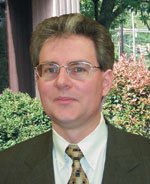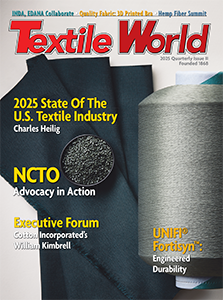FRANCE — April 5, 2016 —France is the 6th exporter of textile machinery worldwide and Turkey is its second most important market. ITM is the leading textile machinery fair in Turkey.
Hubert TRETSCH (Superba’s marketing manager), President of the Promotion Committee of the French Textile Machinery Manufacturers’ Association (UCMTF), will be at ITM Istanbul June 1-4.
He states, “Our tradition of R & D associated with our long term partnerships with our clients explains why France is exporting around one billion Euros worth of textile machinery each year.” Eventhough there are many opportunities to meet the Turkish customers on their own premises or at such fair as Itma’s, he considers ITM a major opportunity. “ITM is a major regional event and we look forward to meet there our long time customers as well as new ones from Turkey and surrounding countries. Our clients and we share the same goal: be reliable long term partners for our customers. We are not looking for short term profits but to make our companies stronger and stronger to seize the markets opportunities and be able to absorb the difficult years. We are mainly SME’s, often family owned, leaders or co-leaders in their markets. This why we understand each other so well with our Turkish customers who are real entrepreneurs”.
At ITM, the textile and carpet industrialists will be shown the latest technical innovations by the French teams. The stability of these teams allows them to go well beyond the purely technical and address the long term objectives of their customers.
NSC Fibre To Yarn – Hall 3 Booth 318A – with SAMOTEKS
NSC Fibre To Yarn continues to develop and propose Tow To Top lines with the model S200 of stretch breaker followed by the new model of defelter rebreaker model D5GC40 and GC40 chain gill. As finisher m/c, the FMV41/42 vertical rubbing frame takes place.
Recently, NSC Fibre To Yarn has installed semi-worsted lines with SW35 carding m/c (2.5 m or 3.5 m wide), manufactured by N. Schlumberger followed by preparation lines consisting of chain gills model GC 40 and finishers m/c model FMV41/42.
New: NSC offers to modernize recycling lines for acrylic fibres or blended ones by introducing its well-known combing ERA between card and gills. The contribution of the combing ERA is economically essential according to 4 points of view:
4 April 2016
– production: 1 ton per day in 3 deniers (3 shifts).
– cleanliness: 25% of neps less compared with PB family m/c.
– energy consummation: equipment with economic motors.
– reduced consummation of spare parts owing to a new design of kinematic.
NSC Fibre to Yarn is honored to have numerous Turkish customers with whom the machinery manufacturer can improve the machines and adapt them to each customer’s needs.
In order to give the best service in Turkey, an organization of a spare parts have been set up in Gaziantep with the BILGE/Automation company.
LAROCHE- Hall 3 Booth 302
With close to a century of experience in the difficult art of textile processes, LAROCHE offers high quality, efficient and proven solutions and provides turnkey solutions from sales, engineering, manufacturing and worldwide services.
At ITM, LAROCHE will show a full range of products made from their latest technologies. After 20 years of experience in Airlay technology Laroche will notably introduce the new AIRFELT with “RESINFELT” option, and the latest innovations in used clothes recycling processes.
LAROCHE has been a strong partner to many major Turkish companies in the nonwoven and recycling industries for more than 30 years. LAROCHE provides a full range of engineering, development and support services for turnkey projects.
In Cours-La Ville, France, a 2,000-square-meter technical center equipped with one Airfelt with “Resinfelt” option and 2 “Flexiloft” Airlays with needle loom and thermobonding oven, allows to test and prove the technical solutions on industrial lines. Customers are welcome to use these facilities to develop their new products.
The company’s sales, service and spare parts teams follow up each customer throughout the life time of the equipment. With 2 manufacturing plants and after sales support, LAROCHE serves highly satisfied customers in more than 70 countries.
SUPERBA – Hall 2 Booth 214
SUPERBA, a member of the Vandewiele group of companies since July 2015, will be present at ITM in Istanbul in on a common booth under the Vandewiele roof.
SUPERBA, already mastering the sophisticated space-dyeing technique for years, will show their latest machine type MCD3. This new version is able to continuously dye a bundle of 72 yarns, with a production of up to 280Kgs/h combined with a TVP3 line and up to 400Kgs/h with a DL5 line with a range of 6 spot colors plus 1 base shade. Thanks to its unique high-speed piezo-electric linear actuator technology, the machine offers a wide range of spot patterns, from short-space (20mm) to extra-long-space (150m), under the control of a powerful pattern creation software (Yarndraw3).The new MCD3 also permits a new style of space-dyed yarn thanks to its exclusive bi-color technology, offering the carpet designer a wider range of possibilities: MCD3 bi-color space-dyed rugs will be shown at ITM.
The new version of the famous TVP3 heat-setting line is providing many improvements and ergonomic, such as the MLU multi-laying unit with its new MF400 frieze box. This laying unit will also be exhibited on the stand at ITM to demonstrate the ability to switch from straight-set to frieze mode within minutes, instead of 2 hours with the previous equipment. The latest version of the MF400 frieze box integrated inside the MLU also enables to produce a new style of frieze yarn with very even waves and offers the electronic control of the friezing from very light to strong frieze effect.
DOLLFUS & MULLER – Hall 12 Booth 1202 C
Dollfus & Muller, founded in 1811, manufactures endless felts and dryer belts for the textile finishing factories. The company will exhibit:
– compacting sanfor felts for knit finishing;
– sanforizing felts for denim and woven fabrics finishing;
– printing dryer belts for textile printing; and
– sublimation blankets for transfer printing.
Dollfus & Muller will introduce, at ITM, its improved compacting sanfor felt for knit finishing with major evolutions compared with the other products in order to serve better the dyeing houses. The compacting sanfor felt quality brings a special care to the fabrics thanks to its smoothest surface, has an excellent guiding and the best compacting rate in relations with its new exclusive compacting sanfor felt design.
The Dollfus & Muller’s sanforizing palmer felts are ideal for Denim producers. At ITM, the company will show its proven durable Sanfor felts. The Dollfus & Muller’s Sanfor felts are recognised by most of the major machine makers as the best felts.
Furthermore, Dollfus & Muller will display its new durable printing dryer belt quality TAMIP HT 500 NR. This print dryer belt is the most durable printing dryer belt specially designed for pigment printing of bed sheeting. Dollfus & Muller will as well display its exclusive print open mesh belt specially designed for the production of fine fabrics, scarves, flags. These belts have special non marking surfaces which can avoid as well the particles on the back side. Dollfus & Muller has the widest range of printing dryer belts and the strongest dryer belts.
Dollfus & Muller staff will be available for its costumers at the exhibition together with their local compacting sanfor felt representative Mr Ali CETIN from CETIN MAKINE (Lüleburgaz – Kirklareli). The company gives excellent machinery services and keeps stock locally in Turkey of its compacting sanfor felts.
PETIT – Hall 3 Booth 310B
PETIT is the specialist in the trade of accessories for textile machines.
PETIT has a consequent and permanent storage capacity of spare parts with more than 20 000 references multi brand for fine count textile machines especially ICBT and looms for Saurer Diederichs.
All technical drawings for manufacturing of spare parts are compliant with the genuine ones.
An acknowledged know-how with a rich experience in the field of covering, texturizing, twisting.
The company is also a covering spindles manufacturer with a range for bobbin from 400 grs to 2000 grs and rotation speed from 1000 to 30000 rpm.
PETIT and its agent OBEN INNOVATEKS have been actively preparing their ITM offer to meet their customers’ needs and propose them the right solutions.
AESA – Hall 3 Booth 315B
A worldwide leader in air engineering for all textile production processes for natural fibers as well as for man made fibers in all different stages: spinning, knitting, weaving, hosiery, nonwovens, dyeing and finishing. The company is specialized in air-conditioning and waste collection systems for textile factories.
The overall energy saving is becoming a competitiveness factor. The AESA air conditioning plants are contributing in a big way to this goal. For spinning factories, the state of the art is to drive all fans and pumps motors through inverters. For weavings, the latest development called WEAVE DIRECT is capable to reach up to 50 % energy savings. This is possible thanks to a dedicated supply air ducting system where unique and localized WDB type diffusers are placed above each loom. Like this the moisture needed for a good output is conveyed in the right quantity to the right place above the loom, and the overall air requirement can be reduced drastically.
Last but not least the DIGIVENT control system, with latest AESA logic is capable to have even more stable room condition between running and not running high speed machines.
This achievement is possible with AESA’s more than 50 years of experience in this specialized field and is assuring better productivity to AESA’s clients and better yarn and fabric quality to the end user.
AESA recognizes Turkey as a major market and a special organization has been set up to give the Turkish market the best service: agent, direct office, etc…after sales: AESA has a liaison office in Turkey, and Ikiler Tekstil has been the agent for the last several years.
Posted April 5, 2016
Source: French Textile Machinery Manufacturers’ Association (UCMTF)





